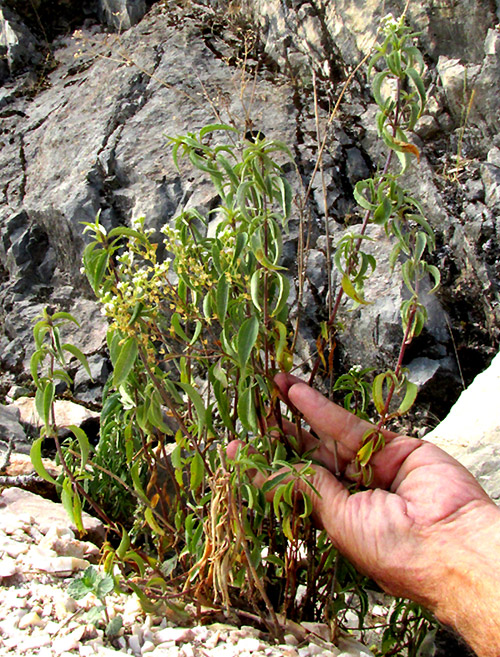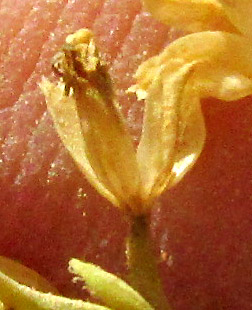Excerpts from Jim Conrad's
Naturalist Newsletter
Entry from field notes dated June 28, 2023, taken beside gravel road running beside the crest of the ridge rising on the southwestern side of Curva de la Doctorcilla, which is near km 18 on the branch road beginning at El Campamento and continuing to El Doctor, and which is numbered Hwy 120, though it branches off the main Hwy 120 running between San Juan del Río and Jalpan; limestone bedrock; elevation ~2930m (~9600 ft), Querétaro, MÉXICO, (N20.85971°, W99.60541°)
PIQUERIA TRINERVIA

Beside the one-lane gravel road cut into the ridgetop, the above much branched, drought stressed, perennial herb rose from gravel at the road's edge. The spot was exposed to intense sunlight, wind and temperature extremes, and currently a long, severe drought was still taking place, so one had to admire the plant's adaptive vigor.

The somewhat thick and hairless leaves arose in pairs at stem nodes. Their sides folded upward, forming blades V-shaped in cross-section, and their margins bore low, broad teeth. Most leaves were prominently three-veined from the blade base. The stems were dark purplish, with only a few scattered, weak hairs.

Up close, it was clear that this was a member of the largest of all flowering plant families, the Composite, Aster or Sunflower Family, the Asteraceae. The inflorescence consisted of numerous flowering heads, or capitula, each capitulum consisting of a green involucre composed of four scale-like bracts and shaped like an urn, surrounding four white florets. Usually only one or two florets were open at one time, and all florets were of the cylindrical, five-lobed disc type, with no tongue-shaped ray florets present. The Aster Family, with over 32,000 known species in over 1,900 genera, is so vast that its species can be hard to distinguish. The mere fact that our plant's capitula produced no ray florets disqualified most species in the Aster Family. Moreover, experience suggested that the capitula's features indicated our plant belonged in the tribe Eupatorieae.

The exceptionally small capitula were arranged in an unusual dispersed and zig-zag manner. Capitula at brach tips bore open florets, while florets lower down already had matured, developed their one-seeded, cypsela-type fruits, and the fruits had fallen out, leaving only empty, dried-out involucres.

One dried-out involucre, however, still contained a single mature floret, shown at the right. This was lucky because, for further identification, one needed to know the nature of the pappus atop the cypsela, and whether any scale-like paleae separated the florets inside the head. The floret in the picture is somewhat hidden by a bract, but the impression is that there's no pappus and no paleae, and that turned out to be right.
The above features led to the small genus Piqueria, currently embracing only about seven species. Our plant was the most commonly documented species, PIQUERIA TRINERVIA, occurring mainly in disturbed sites in upland oak/pine and sometimes fir forests of Mexico and Central America.
Piqueria trinervia bears no English name, but in Spanish is known as Hierba de San Nicolás -- St. Nicholas plant, St. Nicholas being known for his generosity and love of people in general -- and long has been considered a mainstay in traditional Mexican medicine. It can be bought in local mercados, as well as dried in packages online and in certain health food stores.
The Franciscan friar Sahagún's wonderful La Historia General de las Cosas de Nueva España, also known as the Florentine Codex, compiled soon after the Spanish conquest of Mexico, between 1540 and 1585, mentions our plant's use for reducing fever. In the early 1700s, Juan de Esteyneffer recommended it for people with humor colérico -- irascible, easily angered folks. During the late 1800s Mexico's Instituto Médico Nacional described it as antimalarial (against malaria) and antipyretic (reduces fever). The undated work by Celso Gutiérrez Báez entitled Plantas Útiles de Yecuatla, Ver. reports that in the Mexican state of Veracruz Piqueria trinervia is used for bronchitis, gallstones, detoxification, fever, stomachache, pneumonia, nerves, malaria, measles, typhoid and smallpox.
Because of these traditional uses, several scientific studies have been conducted on the plant. The 2017 study by Yadira Rufino-González and others entitled "Piqueria trinervia as a source of metabolites against Giardia intestinalis" found that compounds from our plant were effective against the giarida organism causing an intestinal disorder. The 2022 study conducted by Nimsi Campos-Xolalpa and others entitled "Anti-Inflammatory Activity of Piquerol Isolated from Piqueria trinervia Cav." found that the compound "Piquerol, isolated from Piqueria trinervia Cav., showed anti-inflammatory activity in vitro and in vivo models," and thus might be used in the treatment of a variety of inflammatory conditions. Several older studies like these also can be found on the Internet.